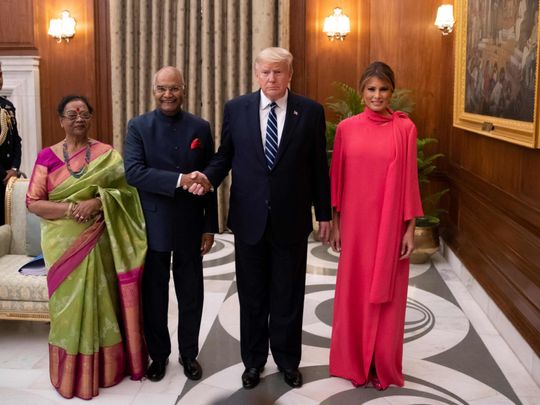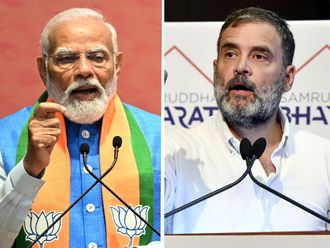
New Delhi: The bonhomie seen at the Motera Cricket Stadium on Monday was once again visible on the lawns of Hyderabad House on Tuesday afternoon as United States President Donald Trump and Indian Prime Minister jointly addressed the media, apprising them about the deliberations between the two leaders and officials on both sides since early Monday.
A $3 billion (Dh11 billion) defence deal signed between the US and India will see the latter shore up its aerial firepower with the acquisition of elite Apache and Romeo attack helicopters from the US.
In addition to that, a major memorandum of understanding (MoU) was signed between US energy giant Exxon Mobil and Indian Oil Corporation (IOC) for the supply of liquified natural gas (LNG) from American shores to India.
Family affair
Also present among the US delegation in Hyderabad House were Trump’s daughter Ivanka and his son-in-law Jared Kushner — both of whom are believed to play key roles as the US president’s advisers.
Trump, in fact, expressed his happiness over Ivanka attending the recent Global Entrepreneurship Summit in Hyderabad and thanked her for her inputs in the bilateral discussions between officials.
While Trump spelt out some of the details of the discussions and was more focused on elaborating on the business end of the talks between the leaders, Modi, in his opening address, praised the visiting leader: “What we saw yesterday [in Ahmedabad] was an unprecedented welcome for an American president … President Trump and me have decided to take our relationship [Indo-US] to the next level. We have had some very positive discussions on every possible aspect of our ties.”
Trump, in his address, termed his current visit to India as a “very special one”.
“Melania [the US First Lady] and I were awestruck by India and the kind of love the country has shown for us. This has been a very productive visit for both of our countries,” the US president said.
$3 billion helicopter deal
While the $3 billion attack helicopter deal was in the pipeline for sometime and it was amply clear yesterday itself in Ahmedabad that such a deal was about to be sealed, what turned out to be a major talking point on both the sides on the second day of the US president’s visit was the MOU between Exxon Mobil and IOC for the import of LNG to India.
That India is seriously considering the US as an alternative source for clean energy has been enunciated in very definitive terms with the signing of this agreement.
The Exxon Mobil chief executive officer, who was present among the delegates on the US side at Hyderabad House, had a nudge from Trump when the US president looked in his direction from the podium and said in a lighter vein: “It’s a big deal, will you be able to handle it? Well, I’m sure you can.”
While the much-anticipated and talked-about trade deal between the two countries is yet to be worked out in finer details and formalised,
Trump said he had a very comprehensive discussion with the Indian prime minister and a “very massive” trade deal is about to happen soon.
Apart from that, Trump also said that India stands to gain from technology-sharing with the US. Development of 5G networks across India is a step in that direction.
Partnership
While Modi spoke about the importance of promoting people-to-people contact and extolled the role played by expatriate Indians and people of Indian origin in American economy and society, Trump underscored the importance of having India as an equal partner in the fight against religious extremism and global terrorism.
In more ways than one, the Hyderabad House event was yet another affirmation of the fact that US-India ties have now reached a point where it will be wrong to see it only through the prism of trade or defence collaboration.
The relationship has grown exponentially since the time of George W. Bush, who had allowed the civil nuclear deal with India, and through the days of Barack Obama’s tenure in the White House, who increasingly saw New Delhi as a counterbalance to China’s growing political and military clout in the Asia-Pacific region.
With Trump, one can certainly say that the transactional nature of US-India relationship is now a thing of the past, though a real big-bang announcement on a trade deal would have definitely been the icing on the cake of this two-day whirlwind tour.












